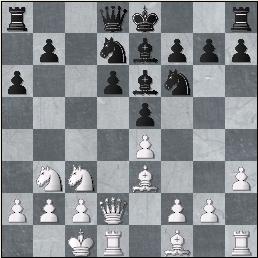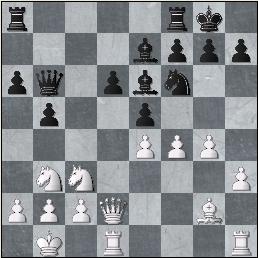26.02.2007
Game of the Round (6)
In the 6th round only one game has been played, and we will examine it presently. Yet I heard it through the grapevine that the other participants have also been seen moving pieces... Well, I really don`t know, this needs to be checked out. Anand,V (2779) - Ivanchuk,V (2750) [B90] 1.e4 c5 2.¤f3 d6 3.d4 cxd4 4.¤xd4 ¤f6 5.¤c3 a6 6.Ґe3 e5 7.¤b3 Ґe6 8.Јd2 ¤bd7 9.0-0-0 Ґe7 10.h3!? An interesting decision. White retains an opportunity to carry out both a plan with f2-f4 and a routine idea of g2-g4-g5. In the latter case, as distinct from the f2-f3-plan, black knight is deprived of an opportunity to make itself comfortable on h5 because of Ґf1-e2. 10...b5 11.g4 0-0 12.ўb1 Јc7 Black renews the possibility to meet g4-g5 with b5-b4. To move 12...¦c8 would be imprecise because of 13.g5 (13...b4 is not possible, and on 13...¤h5 there is an unpleasant reply 14.Ґe2) and somewhat excessively inventive 13...¤xe4 14.¤xe4 d5 does not help: after 15.¤c3 15...d4 16.Ґxd4 White is a pawn up. 13.Ґg2 Interesting is 13.f4!?, on which there could have followed 13...¦fc8 14.f5 b4 15.fxe6 bxc3 16.exf7+ ўxf7 17.Јg2 cxb2 with an unclear position. 13...¤b6 14.Ґxb6 Јxb6 15.f4 15...Ґc4! After this practically textbook decision it soon becomes clear that Black has achieved an advantage in the opening. Obviously worse would be 15...b4 16.¤d5; also bad is 16...¤xd5? 17.exd5 Ґd7 18.fxe5, and after 16...Ґxd5 17.exd5 there is no time for 17...a5? because of 18.fxe5 16.g5 After16.¤d5 ¤xd5 17.exd5 Ґxb3 (the simplest way is just to exchange those pieces, after17...exf4 18.Јxf4 Ґf6 19.¤d4 both of them would become sources of trouble for Ґlack) 18.cxb3 exf4 19.Јxf4 Ґf6, and Black stands better. 16...¤h5 17.fxe5 dxe5 18.¤d5 Ґxd5 19.exd5 Ґd6 20.¤a5 It is necessary to blockade the pawns. Attempts like20.Јe1 a5 21.Јh4 (there is a strong desire to transfer the knight on e4:21.¤d2 a4 22.¤e4 ¤f4 23.Ґf3 b4, but that will do no good) 21...a4 22.¤c1 ¤f4 23.Ґe4 g6=/+ make it obvious that White`s turn to create threats will not come today. The advanced black pawns are very unpleasant. 20...f5! 21.gxf6 ¦xf6 Black`s advantage becomes more and more evident. Passed d5-pawn is securely blockaded in contrast to the black e-pawn, which is going to start advancing soon. 22.¦hf1 ¦e8 23.¦xf6 ¤xf6 24.¤b3 White reasonably avoids 24.¤c6. On most probable advance e5-e4 there all the same follows ¤b3(c6)-d4, and there is a hope to "settle" the knight on some other square at that, for instance, after 24...b4 25.Јe2 the knight follows via b3 and d2 to e4 or c4 24...e4 25.¤d4 There is no condemning this move as with its help White has managed to extricate himself from an unpleasant position quickly enough; still it is not exactly clear what he has planned to do if Black would have simply taken a pawn two moves later. As indicated by Maxim Notkin on the site chesspro.ru, transferring the bishop to e6 won`t work: 25.h4 e3 26.Јe2 Јc7 27.Ґh3 Јc4! 28.Ґe6+ ¦xe6 29.Јxc4 bxc4 30.dxe6 e2! 31.¦e1 cxb3 32.axb3 ўf8-/+ and in the endgame two minor pieces is obviously stronger than the rook due to the defective white structure. Nevertheless it seems quite possible for White to choose a dangerous at first sight, but tactically justified way 27.¦d3!? Јc4 28.¤d4 ¤xd5 29.¤f5 (after 29.¤xb5 Јxb5 30.Ґxd5+ ўh8 strong passed pawn determines Black`s advantage, all the more that it has to be blockaded with the queen) 29...¤f4 (29...¤b4 30.Ґd5+ ¤xd5 31.¤xd6 ¤f4 32.¤xc4 ¤xe2 33.¦xe3 and White manages to save himself) 30.Јg4 Јc7 31.¦xe3 ¦xe3 32.¤xe3 Јc5 33.Јf3 ¤xg2 34.Јxg2! g6=/+, endgame looks good for Black, but nevertheless White should not lose. 25...¦e5 26.c3 26...Јc5?! Now White manages to come through unscathed. It was worth its while to take the pawn 26...¦xd5 with an advantage, queen`s invasion along the now opened diagonal is of no use to White: 27.Јc2 ¦e5 28.Јb3+ ўh8 29.Јf7 Јc7 27.Јe2 ¤xd5 28.Ґxe4 ¤f6 29.¤b3 Јc7 30.¤d2 Јe7 after the "plucky" move30...b4!? White has every right to think over 31.Јxa6 bxc3 32.bxc3!? with an extra pawn in an unclear position. 31.Јd3 Ґc5 It is important that 31...¦xe4? won`t work here 32.¤xe4 Јxe4 (32...¤xe4 33.¦e1) 33.Јxe4 ¤xe4 34.¦d4; in the rook endgame after 31...¤xe4 32.¤xe4 ¦xe4?! 33.Јxd6 Јxd6 34.¦xd6 ¦e3 35.¦xa6 ¦xh3 36.¦a5 black pawns are no faster then their white counterparts. In the latter variation it will be correct to retain bishop`s advantage over knight 32...Ґc7! and the minimal advantage. It seems worthwhile for White to resort to self-pinning 33.¦e1!?, and Black cannot exchange the queens due to the inadequate defense of his king, and any progress is impossible without this exchange. 32.Ґg2 1/2-1/2
XXIV SuperGM Morelia/Linares MEX/ESP (6), 24.02.2007



ALL ARTICLES BY AUTHOR
